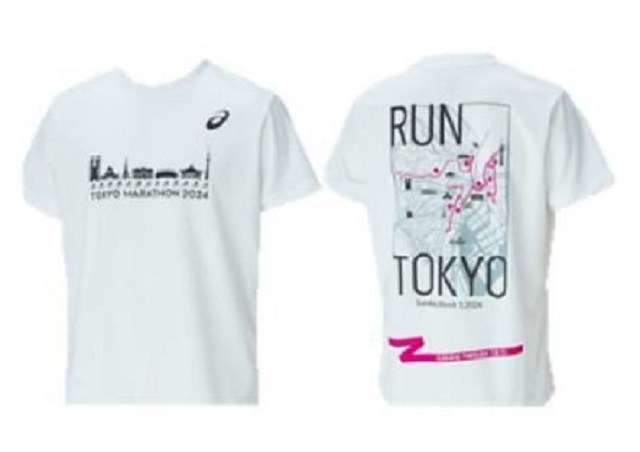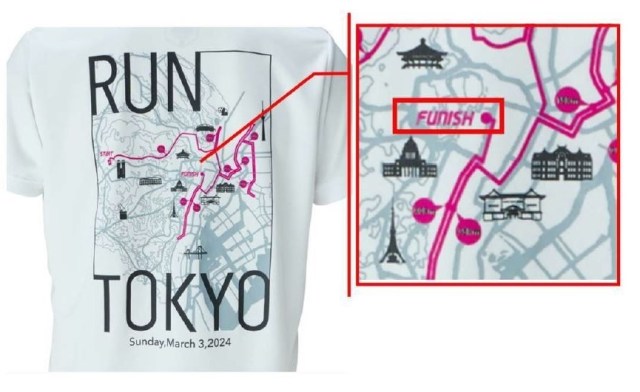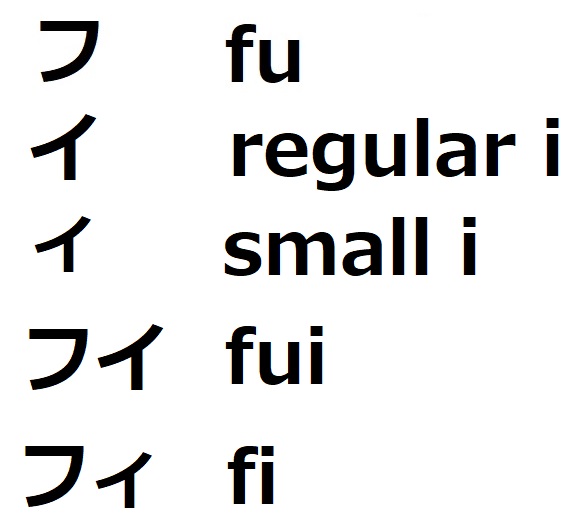
Things started off OK, but didn’t finish quite right.
The Tokyo Marathon was only held for the first time in 2007, but it’s quickly become one of the premier distance running events in Japan. Conditions for this year’s iteration look to be just about ideal, with clear skies and mild temperatures forecast for the start of the race at 9:10 a.m. on Sunday. But while no participants have started running just yet, there’s already been a stumble from sponsor and supplier Asics.
Among other commemorative items, the sportwear company is selling a Tokyo Marathon 2024 Limited-edition Souvenir T-shirt through its online shop and at brick-and-mortar vendors. Available in white, black, or navy blue, the front of the shirt has depictions of some of the famous pieces of Tokyo architecture the runners will go by during the race, and on the back is a map of the course with “RUN TOKYO” written in large lettering.
That’s not the only bit of English text on the shirt, though. The beginning and end of the course are also marked in English, as “START” and…
…”FUNISH.”
Even in a country where the fondness for loanwords often outstrips skill at spelling them, this is a pretty big blunder. The English “finish” shows up frequently in signage, user interfaces, and graphic design in Japan, so it’s surprising to see that funish slipped through to the shirts’ production phase.
So how did this happen? One possibility has to do with the structure of the Japanese language. As we discussed in our explanation of how a sign in Japan mistakenly directed motorists to a fart for 30 years, in the Japanese language consonants generally have to be followed by a vowel. However, much like how Japanese famously doesn’t have an “L” sound, not every consonant/vowel combination we have in English exists in Japanese. Within orthodox Japanese linguistics, the only vowel that F can be followed by is U, which could explain why no one at Asics caught the funish mistake before the shirts were printed and put on sale.
There is a way to brute-force a fi sound when writing Japanese by using katakana, the script used for writing foreign language-sourced words. Even then, though, it involves using the katakana character for “fu” and adding a smaller version of the katakana for “i” immediately after.
However, this “fi” sound isn’t something that technically exists within Japanese pronunciation, and its rendering still contains the character for “fu,” so once again, “funish” might not have immediately jumped out as wrong to Asics’ Japanese staff, including whoever input the text in the design phase.
Then, of course, there’s the non-linguistics-related possible explanation, which is just that I and U are next to each other on a standard keyboard layout, and that funish was just an errant keystroke typo.
Regardless of how it came about, though, Asics has issued an apology for the mistake, saying “We deeply apologize for the trouble caused to our valued customers who purchased the affected items” and offering full refunds, even if the shirts have already been worn, adding “Moving forward, we will be making thorough efforts to improve our quality control, and we ask for your understanding and continued support.”
While it’s definitely an embarrassing mistake for Asics, Twitter reactions have been far from universally negative.
“Funish…ah man, that’s kinda cute.”
“I think they should just go ahead and make the actual banner at the end of the course say funish now.”
“I feel like even a junior high school student would be able to spell finish.”
“I bet someone got royally chewed out for this.”
“I think the designer and Asics person in charge of the project should both get fired.”
“I actually want one of these shirts even more now. It’s like a collector’s item. ‘I hope people think of it like Fun + finish = funish.’”
“It sounds like a mix of ‘fun + run + finish,’ meaning ‘Let’s have a fun run all the way to the end.’ I think this might be a misprint that goes on to become a new buzzword.”
In all fairness, “funish” is exactly the sort of pun-adjacent wordplay that Japan has a major soft spot for, so there’s a good chance that some people who ended up with misprinted shirts will be happy to keep them. For those that want a properly spelled finish to the situation, Asics will provide full refunds through its online return form here.
Source: Asics via IT Media, Twitter
Top image: Asics
Insert images: Asics, SoraNews24
● Want to hear about SoraNews24’s latest articles as soon as they’re published? Follow us on Facebook and Twitter!




 Tear up the stage and the 2020 Tokyo Marathon with kabuki-inspired ASICS sneakers
Tear up the stage and the 2020 Tokyo Marathon with kabuki-inspired ASICS sneakers Asics Ukiyo-e x Manga sneakers combine modern and traditional Japan for Tokyo Marathon 2021
Asics Ukiyo-e x Manga sneakers combine modern and traditional Japan for Tokyo Marathon 2021 Ninja-themed sneakers are the perfect footwear for the contemporary shadow assassin
Ninja-themed sneakers are the perfect footwear for the contemporary shadow assassin Japanese government to make first change to romanization spelling rules since the 1950s
Japanese government to make first change to romanization spelling rules since the 1950s ASICS challenges public to beat two Japanese professional soccer players at their own game
ASICS challenges public to beat two Japanese professional soccer players at their own game Foreigner’s request for help in Tokyo makes us sad for the state of society
Foreigner’s request for help in Tokyo makes us sad for the state of society Seaside scenery, history, and so many desserts on Yokohama’s Akai Kutsu【Japan Loop Buses】
Seaside scenery, history, and so many desserts on Yokohama’s Akai Kutsu【Japan Loop Buses】 Should you add tartar sauce to Japanese curry rice? CoCo Ichi makes diners an unusual offer
Should you add tartar sauce to Japanese curry rice? CoCo Ichi makes diners an unusual offer Japanese city loses residents’ personal data, which was on paper being transported on a windy day
Japanese city loses residents’ personal data, which was on paper being transported on a windy day McDonald’s new Happy Meals offer up cute and practical Sanrio lifestyle goods
McDonald’s new Happy Meals offer up cute and practical Sanrio lifestyle goods French Fries Bread in Tokyo’s Shibuya becomes a hit on social media
French Fries Bread in Tokyo’s Shibuya becomes a hit on social media Mt. Koya planning to instate visitor’s tax to cope with huge tourist numbers
Mt. Koya planning to instate visitor’s tax to cope with huge tourist numbers Red light district sushi restaurant in Tokyo shows us just how wrong we were about it
Red light district sushi restaurant in Tokyo shows us just how wrong we were about it Harajuku Station’s beautiful old wooden building is set to return, with a new complex around it
Harajuku Station’s beautiful old wooden building is set to return, with a new complex around it Kyoto’s 100 Demons yokai monster parade returns!
Kyoto’s 100 Demons yokai monster parade returns! Japanese ramen restaurants under pressure from new yen banknotes
Japanese ramen restaurants under pressure from new yen banknotes Studio Ghibli releases new action figures featuring Nausicaä of the Valley of the Wind characters
Studio Ghibli releases new action figures featuring Nausicaä of the Valley of the Wind characters New private rooms on Tokaido Shinkansen change the way we travel from Tokyo to Kyoto
New private rooms on Tokaido Shinkansen change the way we travel from Tokyo to Kyoto Tokyo Tsukiji fish market site to be redeveloped with 50,000-seat stadium, hotel, shopping center
Tokyo Tsukiji fish market site to be redeveloped with 50,000-seat stadium, hotel, shopping center Beautiful Ghibli sealing wax kits let you create accessories and elegant letter decorations【Pics】
Beautiful Ghibli sealing wax kits let you create accessories and elegant letter decorations【Pics】 Studio Ghibli releases Kiki’s Delivery Service chocolate cake pouches in Japan
Studio Ghibli releases Kiki’s Delivery Service chocolate cake pouches in Japan New definition of “Japanese whiskey” goes into effect to prevent fakes from fooling overseas buyers
New definition of “Japanese whiskey” goes into effect to prevent fakes from fooling overseas buyers Our Japanese reporter visits Costco in the U.S., finds super American and very Japanese things
Our Japanese reporter visits Costco in the U.S., finds super American and very Japanese things All-you-can-drink Starbucks and amazing views part of Tokyo’s new 170 meter-high sky lounge
All-you-can-drink Starbucks and amazing views part of Tokyo’s new 170 meter-high sky lounge More foreign tourists than ever before in history visited Japan last month
More foreign tourists than ever before in history visited Japan last month New Pokémon cakes let you eat your way through Pikachu and all the Eevee evolutions
New Pokémon cakes let you eat your way through Pikachu and all the Eevee evolutions Disney princesses get official manga makeovers for Manga Princess Cafe opening in Tokyo
Disney princesses get official manga makeovers for Manga Princess Cafe opening in Tokyo Sales of Japan’s most convenient train ticket/shopping payment cards suspended indefinitely
Sales of Japan’s most convenient train ticket/shopping payment cards suspended indefinitely Sold-out Studio Ghibli desktop humidifiers are back so Totoro can help you through the dry season
Sold-out Studio Ghibli desktop humidifiers are back so Totoro can help you through the dry season Japanese government to make first change to romanization spelling rules since the 1950s
Japanese government to make first change to romanization spelling rules since the 1950s Ghibli founders Toshio Suzuki and Hayao Miyazaki contribute to Japanese whisky Totoro label design
Ghibli founders Toshio Suzuki and Hayao Miyazaki contribute to Japanese whisky Totoro label design Doraemon found buried at sea as scene from 1993 anime becomes real life【Photos】
Doraemon found buried at sea as scene from 1993 anime becomes real life【Photos】 Tokyo’s most famous Starbucks is closed
Tokyo’s most famous Starbucks is closed One Piece characters’ nationalities revealed, but fans have mixed opinions
One Piece characters’ nationalities revealed, but fans have mixed opinions We asked a Uniqlo employee what four things we should buy and their suggestions didn’t disappoint
We asked a Uniqlo employee what four things we should buy and their suggestions didn’t disappoint Princesses, fruits, and blacksmiths: Study reveals the 30 most unusual family names in Japan
Princesses, fruits, and blacksmiths: Study reveals the 30 most unusual family names in Japan Pokémon Center apologizes for writing model Nicole Fujita’s name as Nicole Fujita
Pokémon Center apologizes for writing model Nicole Fujita’s name as Nicole Fujita Sesame Street Fighter, the most badass children’s TV show ever (if only there were a show for it)
Sesame Street Fighter, the most badass children’s TV show ever (if only there were a show for it) The surprising reasons why some hiragana aren’t allowed to be used on Japanese license plates
The surprising reasons why some hiragana aren’t allowed to be used on Japanese license plates Sapporo Marathon moves online, becomes way more chill about it all
Sapporo Marathon moves online, becomes way more chill about it all You have cat to be kitten us with these totally OTT kitty T-shirts!【Pics】
You have cat to be kitten us with these totally OTT kitty T-shirts!【Pics】 Japanese Twitter invites you to run the adorable Snoopy marathon hiding in Tokyo
Japanese Twitter invites you to run the adorable Snoopy marathon hiding in Tokyo Want everyone to lick their lips when they look at you? This curry shirt will have them drooling
Want everyone to lick their lips when they look at you? This curry shirt will have them drooling Japanese actor’s unfortunate choice of t-shirt has net users amused, doubting his English ability
Japanese actor’s unfortunate choice of t-shirt has net users amused, doubting his English ability Studio Ghibli now has a Hawaiian shirt and skirt collection【Photos】
Studio Ghibli now has a Hawaiian shirt and skirt collection【Photos】 Japanese company Yellow Hat hilariously mistakes Pizza Hut for Italian dish-themed headwear
Japanese company Yellow Hat hilariously mistakes Pizza Hut for Italian dish-themed headwear Embarrassing blunder spotted on PlayStation 5 store has Japanese Twitter in stitches
Embarrassing blunder spotted on PlayStation 5 store has Japanese Twitter in stitches Dragon Ball master’s Hawaiian shirt is here to meet your mature cosplay needs
Dragon Ball master’s Hawaiian shirt is here to meet your mature cosplay needs Japanese Twitter users make Osaka Metro’s English translation mistakes into running joke, memes
Japanese Twitter users make Osaka Metro’s English translation mistakes into running joke, memes Tokyo Bon Japanglish song is a crazy way to learn Japanese 【Video】
Tokyo Bon Japanglish song is a crazy way to learn Japanese 【Video】 Design-your-own-Pokémon-T-shirt service launches at Uniqlo, dozens of species to work with【Pics】
Design-your-own-Pokémon-T-shirt service launches at Uniqlo, dozens of species to work with【Pics】 Trying on Amazon Japan’s low-rated tattoo shirt to feel like a Showa-era punk
Trying on Amazon Japan’s low-rated tattoo shirt to feel like a Showa-era punk
Leave a Reply